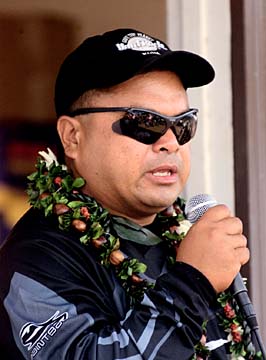On December 2, 1994, Benjamin Cayetano was elected for Governor of Hawaii, and was the first Filipino-American to serve as a state governor in the United States. He left office in 2002, but during his service as governor, he spear-headed a number of sweeping social reforms. He instituted tax cuts, championed school reform, and signed the first legalization of medicinal marijuana in the United States, a topic that is still controversial today, 8 years after the fact. However, perhaps more intriguing than his great accomplishments are his humble beginnings.

Cayetano advocated after school programs, medicinal marijuana, and economic stimulus, but probably not all at once
Cayetano was described as a “latchkey kid” and didn't attend college after graduating high school in 1958. As a young father, he instead worked in a series of menial labor jobs to support his family. Upon being subjected to hiring practices he viewed as racially motivated and politically unfair, Cayetano decided to do something about it. He moved his family to Los Angeles in 1963, where he attended UCLA and eventually earned a law degree in 1971. In 1974 he was elected to the House of Representatives to hold the seat for Honolulu. In 1986 Cayetano became lieutenant governor of Hawaii, and in 1994 he was elected governor.

Benjamin Cayetano, delivering a speech, wearing leis
Benjamin Cayetano's climb to power is significant for the Filipino American community. His feat certainly makes holding a government office within reach for any aspiring Filipino American youths. It's not so far fetched to say that even the Office of President is within reach for Filipino Americans. (Especially so now that our current president is a member of a minority.) Cayetano's story makes it clear that it is possible to make a difference in society, even those from a poor background can rise up and take a stand. In fact, the school reform introduced by Cayetano was inspired by the hardships he faced in childhood. State funded after school programs would give students a place to be motivated and feel belonged.

Brandon, the son Benjamin worked to
support after high school, also in lei atire
Notably, Cayetano's beginnings are very relatable to many people both in the Filipino American community and outside. Working hard to support a new family with limited income is a daunting task, yet it is a situation that a lot of people find themselves in. Now, not everybody is going to become the governor of Hawaii, but Cayetano's story shows that there is more to be had and earned beyond working a dead-end job countless hours a week. So while Cayetano made significant headway for Filipino Americans by becoming the United States' first Filipino American governor, perhaps the inspiration he gives stems more from his humble beginnings than his great accomplishments.

Cayetano has written a memoir about his rise to power
-RZ
 TFC has developed its own shows that showcase and promote various Filipinos and Filipino-Americans world-wide. Wowowee is probably considered one of the most popular shows on The Filipino Channel. It is a variety show that often features Filipino and Filipino-American celebrities. It is normally filmed in the Philippines but has gone on tours in the past. This year, Wowowee went on a world-wide tour to celebrate its 4th anniversary. The show itself is comprised of a variety of segments. One is Hep,Hep, Hooray and involves 10 randomly chosen audience members. The audience dances to “Boom Tarat Tarat” while the 10 are chosen. The game itself requires coordination and rhythm with the last person standing becoming the winner. The participants then go on to play in several other segments. Some of the celebrity performances from the United States that have appeared on Wowowee have been the Jabbawockeez and Apl De Ap of the Black Eye Peas. The Philippines has also developed its own reality shows based on American shows such as The Spelling Bee and Pinoy Big Brother.
TFC has developed its own shows that showcase and promote various Filipinos and Filipino-Americans world-wide. Wowowee is probably considered one of the most popular shows on The Filipino Channel. It is a variety show that often features Filipino and Filipino-American celebrities. It is normally filmed in the Philippines but has gone on tours in the past. This year, Wowowee went on a world-wide tour to celebrate its 4th anniversary. The show itself is comprised of a variety of segments. One is Hep,Hep, Hooray and involves 10 randomly chosen audience members. The audience dances to “Boom Tarat Tarat” while the 10 are chosen. The game itself requires coordination and rhythm with the last person standing becoming the winner. The participants then go on to play in several other segments. Some of the celebrity performances from the United States that have appeared on Wowowee have been the Jabbawockeez and Apl De Ap of the Black Eye Peas. The Philippines has also developed its own reality shows based on American shows such as The Spelling Bee and Pinoy Big Brother.